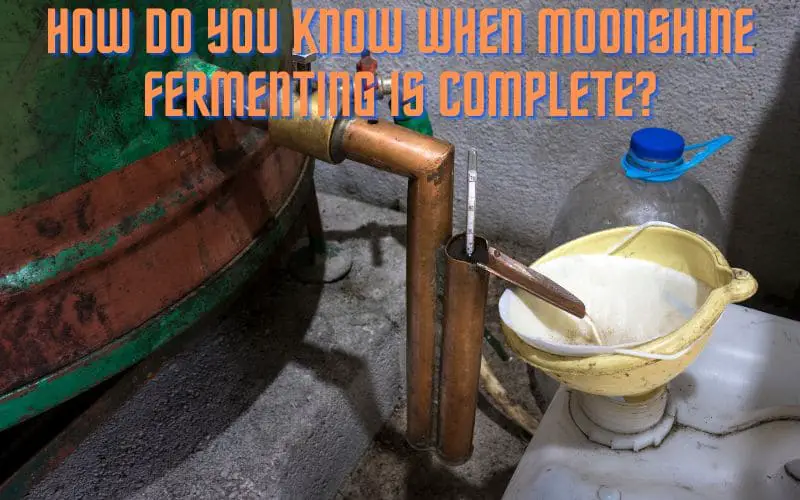How Do You Know When Moonshine Fermenting Is Complete?

Introduction
Welcome to the world of moonshine! In this blog post, we will explore the intriguing process of moonshine fermenting and uncover the secrets to determining when moonshine fermenting is complete. Join us as we delve into the artistry and science behind moonshine production, and discover the factors and testing methods that play a critical role in the fermenting process.
Answer to the Question
So, how do you know when moonshine fermenting is complete? The answer lies in a combination of factors such as temperature, air quality, and ingredients quality, which significantly affect the fermentation process. We’ll explore these factors in detail to shed light on this fascinating aspect of moonshine production.
Factors Affecting Moonshine Fermenting
Temperature
The temperature at which moonshine fermenting takes place plays a crucial role in determining its completion.
- Temperature affects the rate of fermentation. Higher temperatures can speed up the process, but excessive heat can have negative effects on the quality of moonshine.
- Optimal temperature range for moonshine fermenting is typically between 70°F to 85°F (21°C to 29°C).
- Temperature fluctuations can impact the consistency and flavor profile of the final product.
Understanding the relationship between temperature and fermentation is essential for achieving the desired characteristics in moonshine.
Air Quality
Air quality plays a crucial role in the fermentation process of moonshine. Here’s a detailed look at how air quality, ventilation, and air circulation impact the quality of moonshine fermentation:
- Oxygen Levels: Adequate oxygen levels are essential for yeast to thrive during fermentation. Poor air quality, characterized by low oxygen levels, can inhibit the fermentation process and lead to off-flavors in the moonshine.
- Moisture and Humidity: The presence of excessive moisture and high humidity in the air can create an environment conducive to the growth of unwanted microorganisms, ultimately affecting the quality of the moonshine.
- Airborne Contaminants: Contaminants such as airborne particles, dust, and volatile compounds can negatively impact the fermentation process and impart undesirable flavors to the moonshine.
- Ventilation Systems: Proper ventilation systems help maintain optimal air quality within the fermentation area. They facilitate the removal of unwanted gases and maintain a consistent flow of fresh air, contributing to a healthier fermentation environment.
It’s important to monitor and maintain the air quality in the fermentation space to ensure the success of the moonshine fermentation process. By paying close attention to factors such as oxygen levels, moisture, and ventilation, moonshine producers can optimize the quality of their product and achieve consistent results.
Ingredients Quality
The quality of ingredients used in moonshine production directly impacts the fermenting process. We’ll explore the significance of using high-quality ingredients and their role in achieving successful fermentation.
Testing Moonshine Fermenting
Hydrometer Reading
Hydrometer readings are a crucial tool in moonshine fermenting as they provide valuable insights into the progress and completion of the fermenting process. Understanding hydrometer readings and their significance is essential for achieving high-quality moonshine. Here, we’ll delve into the intricacies of hydrometer readings, their interpretation, and their practical application in moonshine production.
When taking hydrometer readings, it’s important to consider the following aspects:
- Specific Gravity: Understanding the concept of specific gravity and how it correlates to the fermentation stage is crucial in determining the alcohol content and sweetness of the moonshine.
- Temperature Correction: The temperature at which the hydrometer reading is taken can affect the accuracy of the measurement. It’s essential to make necessary adjustments for temperature variations.
- Fermentation Progress: Hydrometer readings indicate the progress of fermentation, allowing the distiller to track the changes in sugar levels and alcohol content over time.
The hydrometer serves as an indicator for determining the completion of the fermenting process. By monitoring and analyzing hydrometer readings, moonshine producers can identify the optimal time for completing the fermentation and initiating the distillation process.
Moreover, recognizing the consistency and stability of hydrometer readings is crucial in ensuring that the moonshine has reached the desired alcohol content and flavor profile.
Taste Testing
Taste testing is a crucial method used to evaluate the progress and quality of moonshine fermenting. It involves assessing the sensory characteristics to determine the readiness of the moonshine. Here’s a detailed look at taste testing during the moonshine fermenting process:
- Understanding the Palate: One of the primary aspects of taste testing moonshine is to recognize the different flavors and qualities that develop during the fermenting process. This includes identifying sweet, bitter, and fruity notes along with any off-flavors that may indicate issues in the fermenting.
- Assessment Guidelines: When conducting taste tests, it’s essential to have clear assessment guidelines in place. This ensures consistency and accuracy in evaluating the moonshine’s progress and quality. Factors like aroma, taste, and mouthfeel play a vital role in the assessment.
- Quality Indicators: Taste testing allows for the identification of quality indicators in moonshine, such as the presence of certain desirable flavors and the absence of undesirable characteristics. This helps in determining the readiness of the product for further processing and consumption.
- Comparison with Standards: Moonshine can be compared with established flavor profiles and quality standards to ascertain its readiness. This comparative analysis provides valuable insights into the development of desirable attributes and the mitigation of potential defects.
Conclusion
As we conclude our journey into the world of moonshine fermenting, we’ve uncovered the essential factors that affect the fermenting process and the methods used to test its completion. From understanding the impact of temperature and air quality to the significance of hydrometer readings and taste testing, we’ve gained valuable insights into the art and science of moonshine production. Join us as we continue to shine a light on the mystique and charm of moonshine, where tradition and innovation intertwine.
